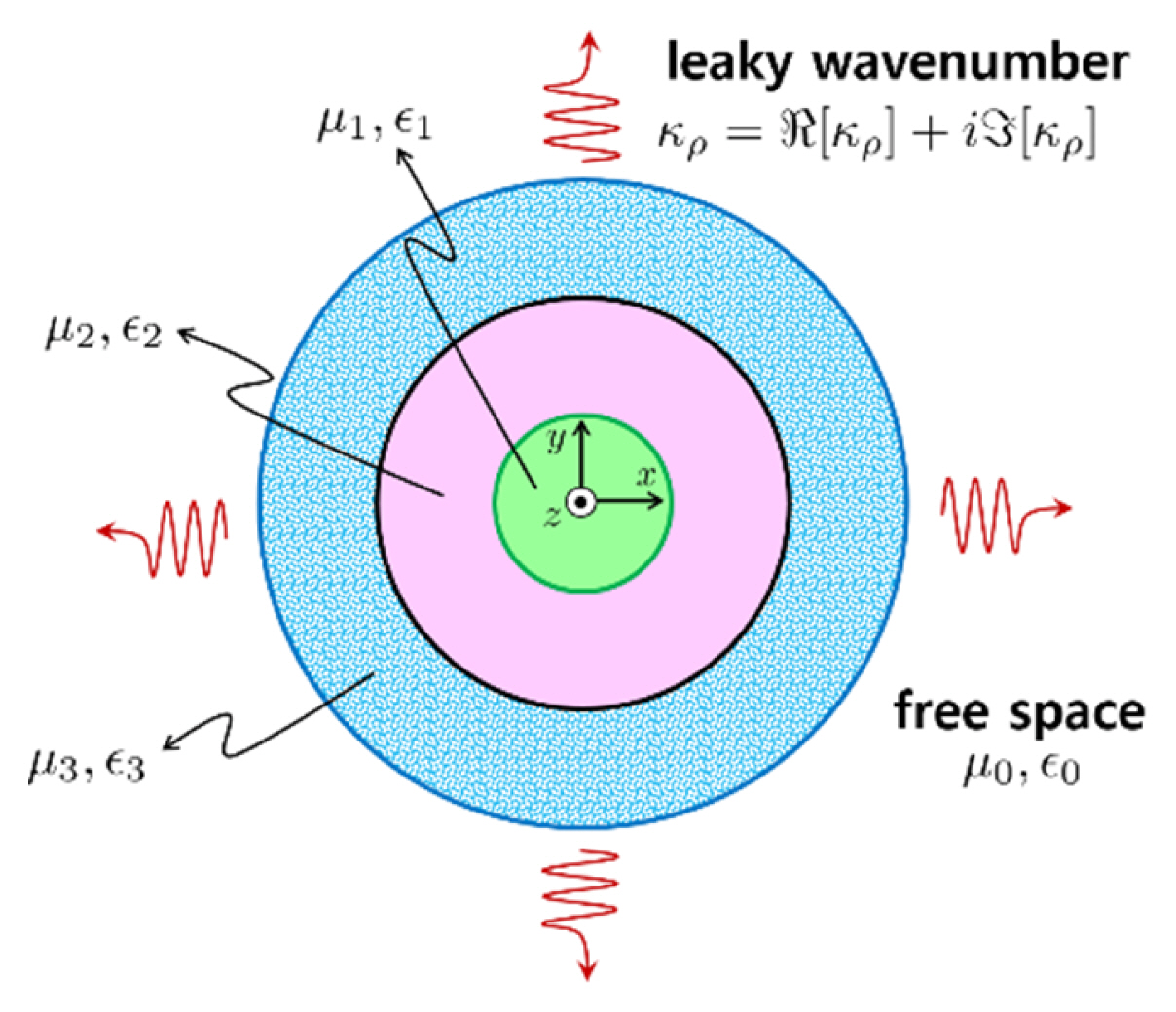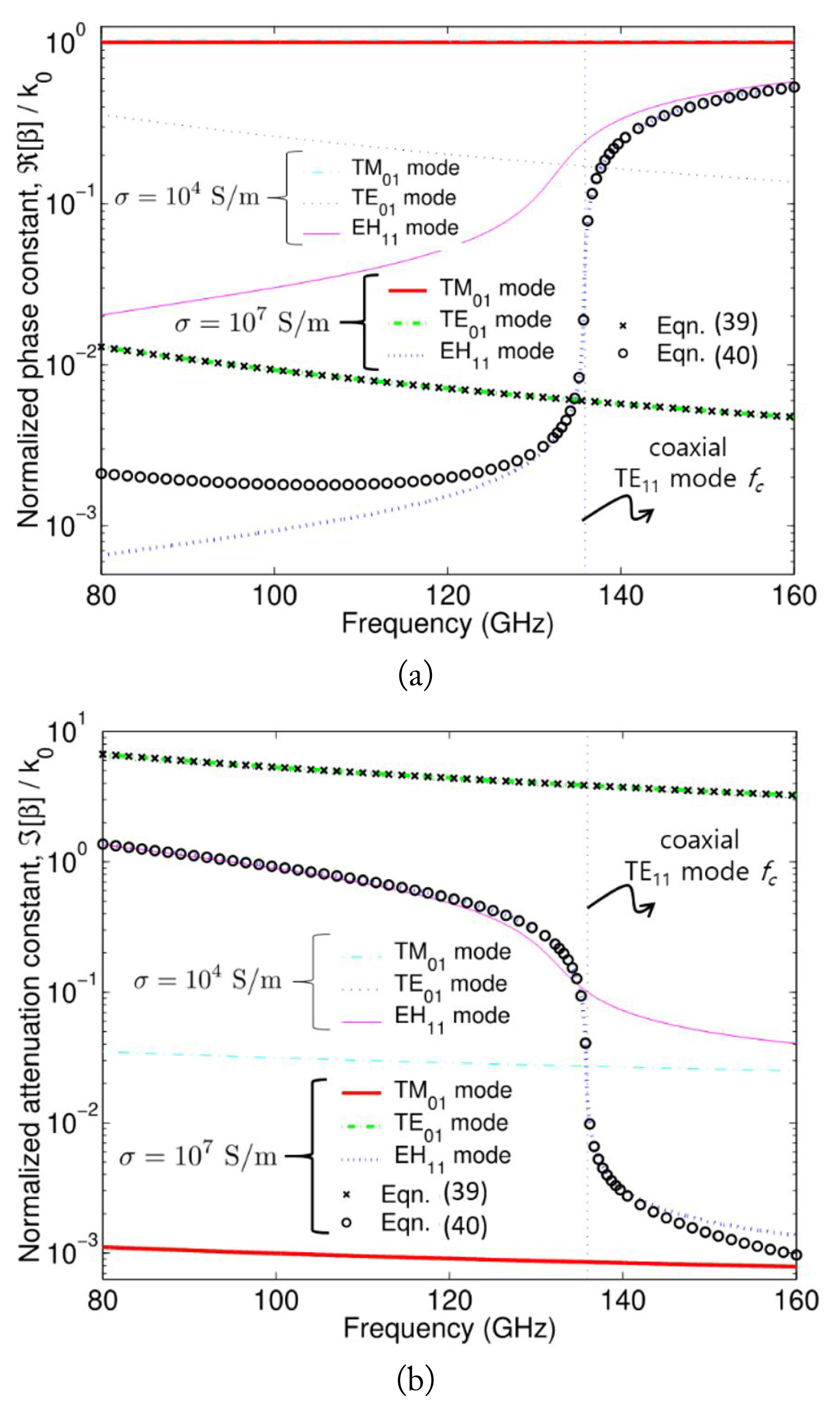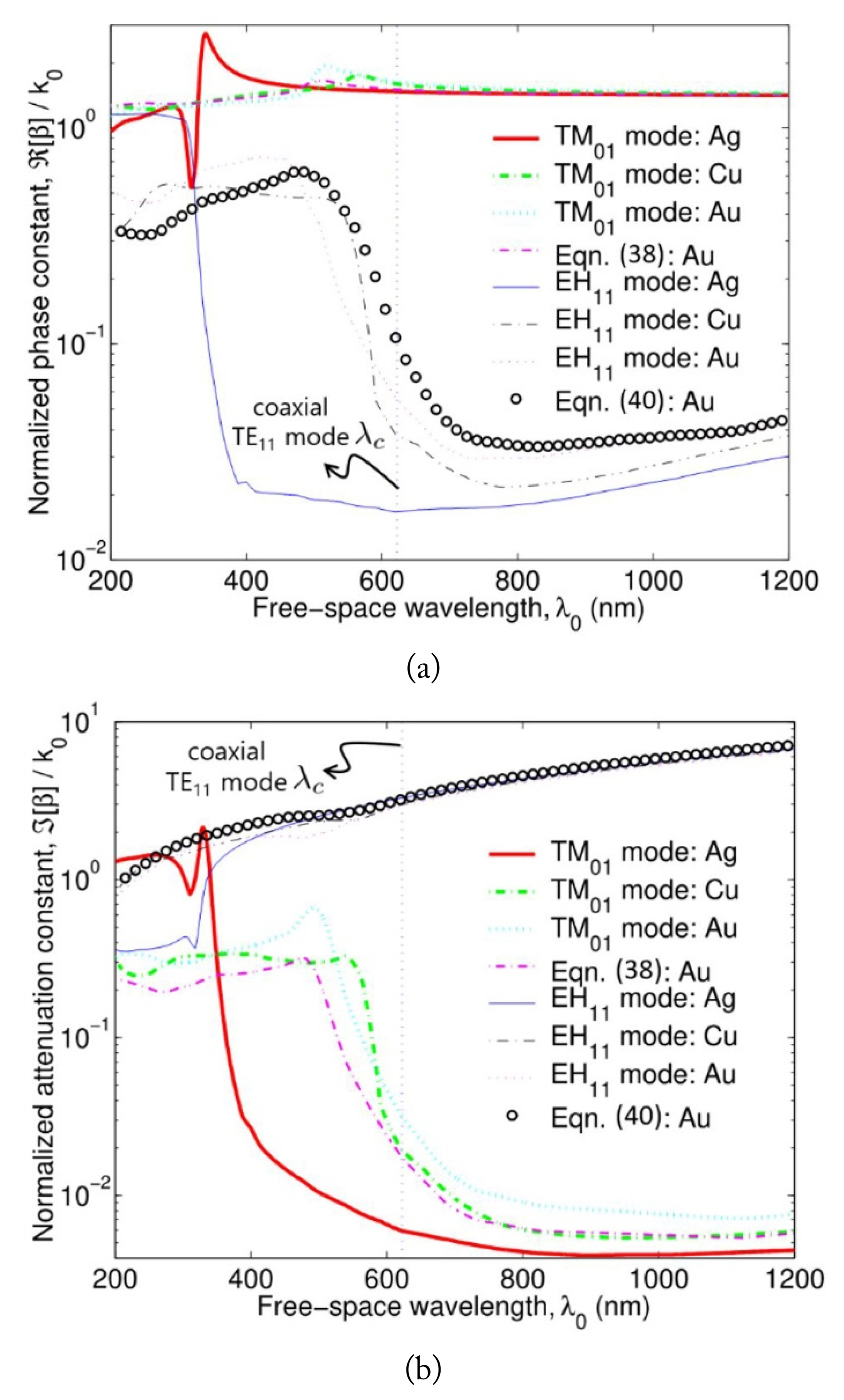Analytical Dispersion Equations of a Lossy Coaxial Waveguide in the Microwave and Visible Spectra
Article information
Abstract
Analytical hybrid-mode dispersion relations of a lossy coaxial waveguide were rigorously analyzed using a mode-matching technique. In order to model a practical coaxial line with inevitable losses, we adopted an all-dielectric coaxial waveguide surrounded by the perfect electric conductor (PEC) boundary. The rigorous dispersion characteristics of the TM01, TE01, and EH11 modes were investigated for lossy coaxial waveguides filled with different electrical conductivities. Based on the exact solutions, approximate but accurate dispersion equations were proposed for the TM0p, TE0p, EHmp, and HEmp modes in order to estimate and compare the behaviors of complex propagation constants in the microwave and visible spectra.
I. Introduction
A coaxial waveguide is a fundamental transmission line to stably guide a light for optoelectronics [1–3] or precisely measure the reflection coefficient and impedance up to millimeter-wave bands [4, 5]. Accurate evaluation of wave propagation through a practical coaxial waveguide is essential for quantifying measurement uncertainty occurring in microwave transmission [5]. Even in the visible spectrum, a nanocoax [3] is one of the promising structures for low-loss propagation composed of plasmonic and photonic modes, where the permittivity can be negative or complex to model real metals at optical frequency.
Since a practical coaxial line is inherently lossy owing to finite electrical conductivity, the TM wave (Ez ≠ 0, Hz = 0) instead of the TEM wave (Ez = 0, Hz = 0) propagates and is gradually decreased in the z-direction. This behavior makes the dispersion analysis of the lossy coaxial waveguide more involved. Therefore, it is of great importance to derive and formulate an exact and rigorous dispersion relation of the lossy coaxial waveguide, which can be modeled as a multilayered dielectric coaxial waveguide [1, 6–8]. A dielectric coaxial waveguide was analyzed using the boundary conditions of an open region [6] and an infinitely lossy outer conductor [7, 8]. In the following sections, we apply a standard mode-matching technique [9] for analyzing a dielectric coaxial waveguide surrounded by the perfect electric conductor (PEC) boundary. A newly-derived rigorous dispersion relation is used to determine precise complex propagation constants for the hybrid, TM, and TE modes in microwave and optical spectra, where we use Davidenko’s method [10, 11] for searching complex roots.
Using the conductor condition or high permittivity approximation, we obtained simplified but accurate dispersion equations useful for characterizing the transmission behaviors of the lossy coaxial waveguide. This means that our rigorous dispersion equations can be utilized to generate the field distributions for the TM0p, TE0p, EHmp, and HEmp modes and formulate the scattering characteristics of canonical coaxial structures used in a coaxial calibration kit [5]. The quasi-TEM mode also yields a closed-form approximate solution for the TM01-mode complex propagation constant, which becomes identical to the propagation constant [5, 7] in the high electrical conductivity limit.
II. Mode-Matching Analysis
A lossy coaxial waveguide can be modeled using a multilayered dielectric coaxial waveguide [1, 6–8] as shown in Fig. 1, where the medium constants—ε1, ε2, ε3 and μ1, μ2, μ3—can be any complex number. We use and omit ei(βz–ωt) for the time convention, where β is a complex propagation constant composed of phase (ℜ[β]) and attenuation (ℑ[β]) constants. The interesting point of the geometry shown in Fig. 1 is that a dielectric coaxial waveguide [1, 6–8] shown in Fig. 2 is entirely surrounded by the PEC boundary. It is known that unwanted multiple leaky modes [11] are inevitably generated in open magnetodielectric waveguides including dielectric coaxial structures [1, 6] with an open boundary as shown in Fig. 2. The existence of leaky phenomena caused by the open boundary makes a dispersion analysis of the dielectric coaxial waveguide much more involved. For instance, the dielectric coaxial waveguide shown in Fig. 2 should satisfy a leaky dispersion relation in an open region as

Modeling of a lossy coaxial waveguide using a multilayered dielectric coaxial waveguide surrounded by the perfect electric conductor (PEC) boundary.

The geometry of a three-layered dielectric coaxial waveguide placed in free space or with an open boundary.
where
where the phase term of a guided wave is ei(κρρ+βz). Eq. (2) indicates that the radial and longitudinal radiation conditions of κρ and β cannot be satisfied at the same time, owing to the fact that the signs of the real or imaginary parts of κρ and β are always different from each other. Contrary to the geometry shown in Fig. 2, the PEC boundary and lossy region (III) introduced in Fig. 1 enable us to block the leaky modes completely and model the conductor loss precisely. This is because the PEC boundary at ρ = b + d is imposed and ε3 can be complex, thus confirming there are no leaky modes and the waves are evanescent in region (III). Therefore, the field representations for regions (I) through (III) as shown in Fig. 1 are formulated using magnetic and electric vector potentials [9]:
where Am, Bm,
and (·)′ denotes differentiation for the entire argument; Jm(·) and Nm(·) are the mth order Bessel functions of the first and second kinds, respectively. Based on the standard mode-matching analysis [9], we enforce Ez-, Eφ-, Hz-, and Hφ-field continuities at ρ = a and b for the mth azimuthal mode. First, by multiplying the Ez- and Hz-field continuities at ρ = a by e−ilφ (l = 0, ±1, ±2, ···) and integrating over 0 ≤ φ ≤ 2π yields, respectively, we get:
where un = κna,
Next, we apply and integrate the Eφ- and the Hφ-field continuities at ρ = a with e−ilφ to obtain the additional field-matching equations, respectively:
where
where vn=κnb. Combining and simplifying Eqs. (11), (12), and (15)–(20), we obtained the mth hybrid-mode dispersion relation as
where |A| is the determinant of a matrix A and a system of simultaneous equations for
The elements of Φm(β) are defined by:
where
Therefore, a complex propagation constant β can be determined by solving Eq. (21). When m = 0, the hybrid-mode dispersion relation shown in Eq. (21) can be divided into
Eq. (30) clearly proves that the TM and TE modes exist for m = 0, although the coaxial waveguide is filled with lossy dielectrics. Since Eq. (21) is applicable to a general coaxial waveguide of any μn and εn, we can use Eq. (21) to analyze canonical waveguides, including the PEC circular and coaxial waveguides. For instance, when μn = μ0 and εn = ε0, the geometry shown in Fig. 1 becomes a PEC circular waveguide with a radius of b + d, and Eq. (21) is thus simplified to
Similarly, when μn = μ0, ε1 → ∞, and ε3 = ε2, the geometry in Fig. 1 is considered a PEC coaxial waveguide. Then, the dispersion equation in Eq. (21) reduces to that of a PEC coaxial waveguide as
III. Numerical Computations
We used Davidenko’s method [10, 11] to search a complex root β by equating |Φm(β)| = 0 as shown in Eq. (21). Davidenko’s method in [11] uses the fourth-order Runge–Kutta method and the Newton–Raphson method in the complex domain, which is suitable for searching the complex propagation constant β. An iterative update equation for the next approximate solution βn+1 is given by
where βn is the current approximate value for β and Δβn+1 is defined in [11, Eq. (10)]. The next differential step Δβn+1 is computed using βn, Δβn, and h, where β0 and Δβ0 are the initial value and step for root searching, respectively, and h is a fixed step of the Runge–Kutta method. As n increases very steeply, βn+1 stably converges to β [10, 11]. We set h = 1 and Δβ0 = β0/100 for all root-searching computations.
The TM01-mode dispersion results of the lossy coaxial waveguide are shown in Fig. 3 using m = 0 and f = 100 GHz, where the TM01 mode (m = 0) is a dominant quasi-TEM mode. We assume that regions (I) and (III) are filled with lossy conductors using

Complex dispersion relation versus electrical conductivity σ for the TM01 mode in the lossy coaxial waveguide using m = 0, f = 100 GHz, 2a = 0.434 mm, 2b = 1 mm, μn = μ0,
where Pn = ε2κn/εnκ2,
Note that setting Um(v2) and
when u → 0, N0(u) and
Note that Eq. (38) is identical to [7, Eq. (37)] even though the boundary conditions for the outer conductors are different from each other. When μn = μ0 and σ ≫ 1, Eq. (38) becomes a complex propagation constant [5] obtained by the transmission line theory and penetration depth δs. Fig. 3 clearly indicates that the thickness (d) of an outer conductor hardly affects complex dispersion relations for σ ≥ 103 S/m and d ≥ 0.2 mm ≈4δs, where δs ≈ 50 μm and σ = 103 S/m. A comparison with [8] provides a favorable agreement when σ ≥ 103 S/m. This is because [8] assumes an infinite outer conductor (d → ∞) and the effects of the thick outer conductor are negligible for high electrical conductivity, where the outer conductor shown in Fig. 1 has finite thickness (d), which differs from [8]. As is also shown in Fig. 3, Eqs. (34) and (38) are practically good formulas in lieu of Eq. (21) for σ ≥ 103 S/m. When σ approaches zero, Eq. (31) predicts that β becomes that of a PEC circular waveguide denoted as ○ in Fig. 3. The insets in Fig. 3 illustrate the normalized real and imaginary parts of the Ez-field distributions when σ = 104 S/m and β ≈ 2161.77+65.96i rad/m. The real and imaginary Ez-fields of the TM01 mode are continuous across the boundaries at ρ = a and b, thus verifying that Davidenko’s method in Eq. (33) is effective for searching the complex root β of a lossy coaxial waveguide. In addition, the magnitude of the Ez-fields is rapidly attenuated within lossy dielectrics in regions (I) and (III), and thus their field distributions illustrate the behaviors of the penetration depth very well.
Fig. 4 shows the dispersion behaviors of the TM01, TE01, and EH11 modes in the lossy coaxial waveguide versus microwave frequency. The TM01 mode has the lowest attenuation when compared with the TE01 and EH11 modes, thus indicating that the TM01 mode is a dominant mode irrespective of σ. Applying Eq. (30) and the conductor condition (|ε1| ≫ 1, |ε3| ≫ 1) yields an approximate dispersion equation for the TE0p mode as

Microwave behaviors of complex dispersion relations of multiple modes in the lossy coaxial waveguide using m = 0 or 1, d = 0.4 mm, and the same parameters given in the caption of Fig. 3. The coaxial TE11-mode cutoff frequency (fc) is computed using an ideal coaxial line: (a) phase constant ℜ[β] and (b) attenuation constant ℑ[β].
where Qn = μnκ2/μ2κn. Similar to Eqs. (34) and (39), the dispersion relation Eq. (21) approximately reduces to
When σ ≥ 107 S/m, the magnitude of ε1 and ε3 becomes very high and thus the TE01- and EH11-mode β computed by Eqs. (39) and (40) agree well with more precise solutions obtained by Eqs. (30) and (21), respectively. In Fig. 4, the attenuation constant (ℑ[β]) of the EH11 mode rapidly decreases above fc ≈ 135.9 GHz. Therefore, the TM01 and EH11 modes coexist and propagate along the lossy coaxial waveguide above fc. Considering Eq. (40), the cutoff frequency (fc) of the lossy EH11 mode can be approximately determined using
Fig. 5 illustrates the dispersion characteristics of the TM01 and EH11 modes within the visible spectrum. To theoretically obtain the dispersion relations of the lossy coaxial wave-guide composed of real metals, we use optical dielectric constants [12] of silver (Ag), copper (Cu), and gold (Au). In the visible spectrum, the real part of the metal permittivity is usually negative caused by plasma oscillation in the metal. Fig. 5 indicates that Eq. (38) is valid within the optical spectrum and the cutoff or transition wavelength (λc) can be obtained by Eq. (40). As a result, our approximate solutions obtained from Eqs. (38) and (40) are useful for predicting the optical behaviors of the TM01 and EH11 modes in the nanoscale coaxial waveguide.

Optical behaviors of complex dispersion relations of silver (Ag), copper (Cu), and gold (Au) coaxial waveguides using m = 0 or 1, a = 75 nm, b = 125 nm, and d = 100 nm, μn = μ0, ε2 = ε0, and ε1 and ε3 (ε1 = ε3) are determined by optical dielectric constants of metals: (a) phase constant ℜ[β] and (b) attenuation constant ℑ[β].
IV. Conclusion
Analytical hybrid-mode dispersion relations of the lossy coaxial waveguide are presented based on the mode-matching technique and the vector potential formulations. Precise phase and attenuation constants of the TM01, TE01, and EH11 modes have been numerically evaluated using the root-searching algorithm based on Davidenko’s method. Approximate but accurate dispersion equations for the TM0p, TE0p, EHmp, and HEmp modes are also proposed and agree well with more rigorous dispersion relations even for low electric conductivity or negative permittivity. Our dispersion solutions can be applied to the theoretical evaluation of a coaxial calibration kit or the analytical determination of light distribution within the optical coaxial waveguide.
Acknowledgments
This work was supported by the research fund of Mokwon University in 2019 and conducted at the Center for Electromagnetic Metrology, Korea Re-search Institute of Standards and Science (KRISS), Daejeon, Korea.
References
Biography

Yong Heui Cho received his B.S. degree in electronics engineering from Kyungpook National University, Daegu, Korea in 1998, and his M.S. degree and Ph.D. in electrical engineering from the Korea Advanced Institute of Science and Technology (KAIST), Daejeon, Korea in 2000 and 2002, respectively. From 2002 to 2003, he was Senior Research Staff with the Electronics and Telecommunications Research Institute (ETRI), Daejeon, Korea. In 2003, he joined the School of Information and Communication Engineering, Mokwon University, Daejeon, Korea, where he is currently a professor. From 2011 to 2012, he was a visiting professor with the Department of Electrical and Computer Engineering, University of Massachusetts Amherst, Amherst, MA, USA. From 2019 to 2020, he was a visiting researcher with the Center for Electromagnetic Metrology, Korea Research Institute of Standards and Science (KRISS), Daejeon, Korea. His current research interests include electromagnetic wave theory and scattering, numerical analysis, design of reflectarrays, and dispersion characteristics of transmission lines.